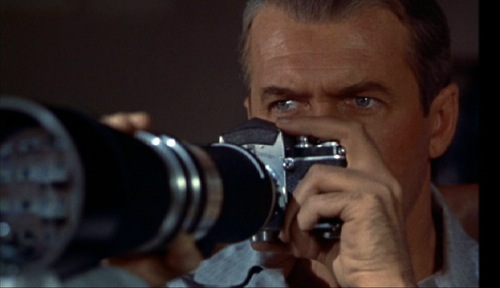Longtime readers of this blog (and I take it on faith that there are one or two of you out there) will know that I am obsessed with the clumsy sublime, Laura Mulvey’s term for the accidental beauty of old-school special effects in classical Hollywood — studio tricks and machinations meant to pass unnoticed in their time, but which become visible and available for fresh appreciation as years go by and the state of the art evolves.
The same reader(s) will be familiar with my interest in virtual spaces and more specifically with the “pocket universes” of storyworlds and certain photographic experiments, such as the one featured in this post on the 2008 Republican National Convention. Well, now I’ve found a new toy to think with: this lovely virtualization of the courtyard in Rear Window (1954), digitally stitched together to recreate not just the large and elaborate studio set on which Alfred Hitchcock filmed the tale of L. B. Jefferies (James Stewart), whose immobilization by broken leg unlocks a visual mobility in which he scans through binoculars the social (and as it turns out, criminal) microcosm of the neighbors in his apartment complex. Here’s the video:
Within this composited space, part Holodeck, part advent calendar, the action of the movie unfolds with new seamlessness and unity, time’s passage marked by sunrises and sunsets, clouds rippling overhead, the moon rising on its nighttime trajectory as the small community bustles through an overlapping ballet of the quotidian. In the middle of it all, a harried husband builds to a murderous rage, disposes of a body, is investigated by Grace Kelly sneaking in from a fire escape.
One of Hitchcock’s undisputed masterpieces, Rear Window is also the go-to example in introductory film courses to illustrate voyeurism, scopophilia, and the cinematic apparatus — a raft of abstract yet efficacious concepts that come out of the “grand theory” tradition of film studies, themselves subject, perhaps, to their own form of clumsy sublimation. I wonder how we might update those ideas in an era of computational revisitation and transformation, in which the half-built, half-imagined territories of classical cinema can be unfolded into digital origami that simultaneously make them more “real” while rendering apparent their intricate artificiality, recoding cinema’s dreamspaces into simulacral form.

